November may be a slow time for sowing and planting in a vegetable garden, but that does not mean there are not some fantastic crops to get in the ground this month. Taking time to plant in November will mean earlier harvests next year, as the crops can bed down roots before winter arrives.
While the month is often more focused on tidying the plot and harvesting the hardy winter crops, it is also a great time to get ahead. There is a great selection of vegetables to plant in November that can get established early, including many legumes, alliums, and salads. The crops can overwinter outdoors in the vegetable garden and burst into life again in spring.
First sowings in November can mean a long harvesting season for any crops which can be planted in fall and spring. Plus, there is scope to plant some leafy crops indoors in November to harvest throughout the winter.

Garlic is a popular vegetable to plant in November
(Image credit: Getty/FotoDuets)
Vegetables to plant in November
I grew vegetables year-round for chefs in vegetable gardens in the UK, which involved sowing, planting, and harvesting crops 12 months a year. This included growing microgreens indoors throughout the winter months.
November may traditionally not be the most productive time for a kitchen garden, but it can still be a hive of activity with crops to get in the ground and vegetables to harvest.
To help you plan a fall gardening checklist and when to plant vegetables, here are my recommendations for seven great vegetables to plant in November:
1. Fava beans
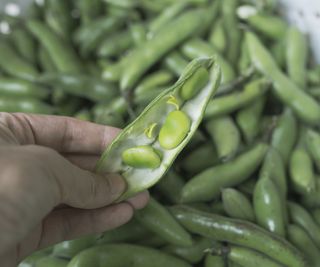
Fava beans sown in fall can provide an earlier spring crop
(Image credit: Getty/Yaorusheng)
Fava beans, a crop also known as broad beans, are versatile vegetables and the shelled beans are used in a wide range of recipes. Fava beans can either be sown in fall or in spring, and beans sown in November will give you an early harvest of fava beans in May or June. The plants are a common crop in kitchen gardens and you can also grow fava beans in containers.
Whether you sow in the fall or not may depend on your soil type or US hardiness zone. If you have heavy soil, a plot liable to waterlogging, or live in a climate with very cold and wet winters, then you are better off waiting until spring to sow outdoors.
When planning to plant fava beans in November, choose a hardy variety – such as ‘Aquadulce’ – and sow beans at least nine inches apart. Simply push the beans two inches deep into the soil and they should germinate quickly, within a few weeks. You can get organic Fava bean ’Aquadulce’ seeds from True Leaf Market.
2. Peas
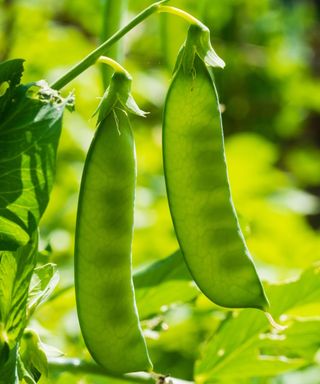
Choose a hardy type of pea for a November sowing
(Image credit: Alamy/ John Richmond)
November is an ideal time to plant early and hardy types of peas in the vegetable garden. These cold-hardy crops will germinate quickly in the moist fall soil and overwinter without any struggles with the winter cold, ready to provide a crop in early spring.
Any planting site mustn’t waterlog over the winter, as the peas are likely to rot sitting in cold and sodden soil for long periods. The type of pea you choose to sow in November is also going to be key. They need to be hardy types, with the likes of ‘Meteor’ and ‘Kelvedon Wonder’ two classics that fit this bill. Make sure the peas you choose are smooth-skinned, rather than wrinkled seeds – as the latter will hold water and are best for spring sowings. See the range of pea seeds available at True Leaf Market.
Any November sowings will be at risk from mice, who love eating pea seeds during the winter. So taking precautions against them is key, and it is going to be the same with sweet peas planted in the fall. Use barriers or try companion planting with allium crops that produce scents that can stop mice from eating sweet pea and pea seeds, or you risk losing all the ones you have sown quite quickly.
3. Salad leaves
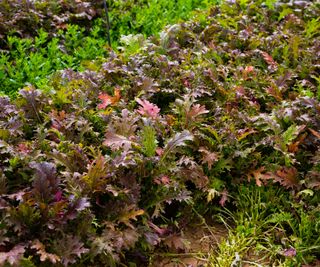
Mizuna comes in red and green-leaved types
(Image credit: Getty Images/JackF)
There are many different types of salad leaves to sow in November, to provide a harvest throughout the colder winter months. Winter leaves are fast-growing vegetables that can be sown in October and November, whether they are grown as fall crops for a greenhouse or raised indoors on a bright windowsill. Leafy crops such as mizuna, claytonia, corn salad, mustards, and spinach are all hardy plants that can grow outdoors or indoors over the winter months.
Growing lettuce indoors, or any other leafy crops, is very simple, provided you have a container with holes for drainage that is filled with a quality potting mix. A sunny windowsill with a temperature of 50˚F to 60˚F can bring on leaves quickly and you can then harvest when the leaves are large enough to eat.
If you are growing the salad leaves outdoors over winter, then they will develop quicker if you provide some protection from the coldest weather. Growers commonly use plastic covers or fleece if they do not have a protected environment, such as a greenhouse or cold frame, to grow their winter leaves. One example is this plastic row cover and hoops set available at Amazon to offer protection to plants.
4. Scallions
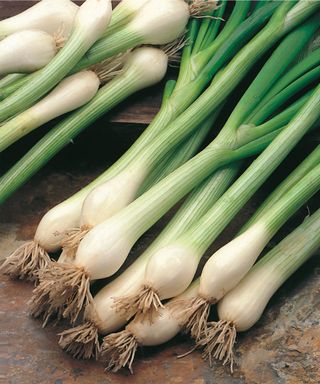
Scallions can be ready to pick 10-12 weeks after sowing
(Image credit: Future)
October and November are normally seen as the time to plant onions and garlic in the garden, but there is another allium crop that it’s possible to sow in November. That crop is scallions, also known commonly as spring onions. You can get hardier varieties of these fast-growing crops to sow in November to overwinter and provide a harvest of stalks, which have a mild onion flavor, come the following spring.
You can grow the hardiest varieties of scallions, including ‘Performer’ and ‘White Lisbon’, virtually all year round. Thinly sow seeds directly onto their growing site in drills around half an inch deep. Once they have germinated, seedlings are best thinned to about two inches apart. Scallions can be grown outdoors in the ground over winter, and in pots (or indoors) for speedier harvests.
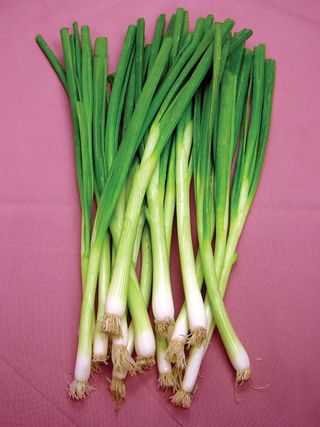
Scallion ‘White Lisbon’ Seeds
A hardy, mild-flavored, fast-growing onion that does not form a bulb. One of the most popular bunching onions among American gardeners
5. Shallots
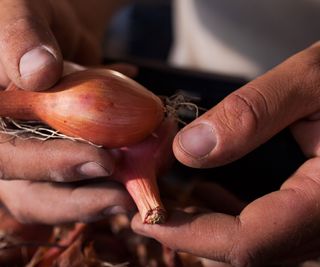
Shallot sets are planted in the fall, or you can grow the crop from seed
(Image credit: Getty/photokitchen)
Shallots are not as commonly grown as onions, but these fantastic allium crops have a milder flavor and can be used in many dishes. Shallots come in round or elongated shapes, with different types found in a range of colors and flavors.
Growing shallots can be easily done from sets planted in late fall or early winter. Each set splits into numerous shallots to harvest – it is common to get six to eight shallots from each set planted when the time comes to harvest shallots next summer.
Plant a set into a hole with just the tip showing above the soil surface and space each set around six inches apart.
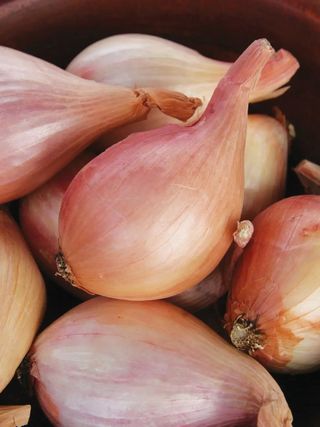
Shallot ‘French Red’ is naturally sweet and mild in flavor. The plants produce an abundance of 1-2″ diameter bulbs that are sweet and similar to a green onion flavor
6. Elephant garlic
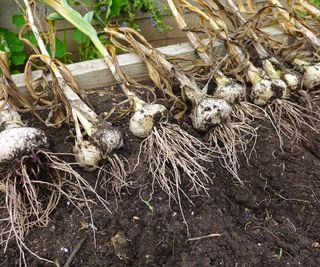
Planting elephant garlic in November gives it time to split into individual cloves
(Image credit: Getty Images/Toni Jardon)
November is often a popular time amongst growers to plant garlic, but it is also the ideal time to start growing elephant garlic. Producing large baseball-sized bulbs, elephant garlic has a milder flavor than regular garlic and wants to be planted in the fall to give the bulb sufficient time to split into individual cloves.
Split an elephant garlic bulb into individual cloves, plant each one 4-6 inches deep and spaced at least eight inches apart. The time to harvest elephant garlic is typically in late summer and, after being cured and dried, the bulbs can be stored for up to 10 months.
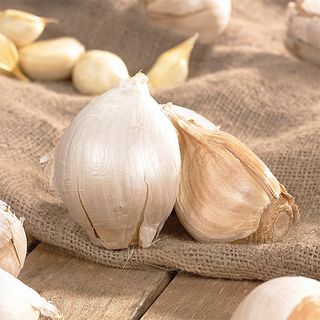
A three-pack of elephant garlic bulbs to plant in the fall and grow in USDA planting zones 5-10. This unique garlic variety produces massive cloves with a mild flavor
7. Asparagus
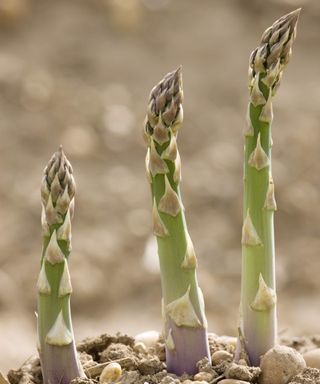
Asparagus comes in green, purple, and white varieties
Asparagus is a highly-prized perennial vegetable. Growing asparagus requires care and patience as it is not a simple vegetable to grow. There is only a short time to harvest asparagus in late spring and early summer, and you need to wait two years from planting to harvesting the first spears. However, established clumps can survive and provide harvests for up to 20 years.
The time to plant asparagus has traditionally been in spring, though you can plant crowns in the fall in warmer climates. If you have milder winters and warm soils at the start of November, asparagus crowns can get established quicker by being planted in the fall.
FAQs
Can I sow carrots in November?
The usual time to sow carrots is from spring through to late summer. So, is November too late for growing carrots? In warmer climates, carrots could potentially be sown in November to grow under kitchen garden cloches. The alternative is to sow carrots in a deep raised bed in a greenhouse or grow carrots indoors over winter, though the crop will likely require grow lights to give them sufficient levels.
We have covered planting vegetables in November, but are you searching for more jobs for this month’s gardening to-do list? If yes, see our guides to plants to prune in November and tender plants to bring indoors this month to protect them from the winter weather. Caring for your trees, shrubs, and perennials at this time of year, whether pruning them or protecting them, ensures they will be healthy for next year and give you a great flowering display.
Although November may be a slow time for sowing and planting in a vegetable garden, there are still some fantastic crops to get in the ground this month. Planting in November will result in earlier harvests next year, as the crops can establish roots before winter sets in.
While the focus in November is often on tidying the plot and harvesting hardy winter crops, it is also a great time to get ahead. Many vegetables can be planted in November and overwintered outdoors in the vegetable garden, ready to burst into life again in spring.
Planting in November can lead to a longer harvesting season for crops that can be planted in fall and spring. Additionally, some leafy crops can be planted indoors in November for winter harvesting.

Garlic is a popular vegetable to plant in November
(Image credit: Getty/FotoDuets)
Vegetables to plant in November
Having grown vegetables year-round for chefs in vegetable gardens in the UK, I have experience in sowing, planting, and harvesting crops throughout the year. November may not be the most productive time for a kitchen garden traditionally, but there are still crops to plant and harvest.
Here are seven great vegetables to plant in November:
1. Fava beans

Fava beans sown in fall can provide an earlier spring crop
(Image credit: Getty/Yaorusheng)
Fava beans, also known as broad beans, can be sown in November for an early harvest in spring. Choose a hardy variety like ‘Aquadulce’ and sow beans at least nine inches apart. The beans should germinate quickly, within a few weeks.
2. Peas

Choose a hardy type of pea for a November sowing
(Image credit: Alamy/ John Richmond)
November is an ideal time to plant early and hardy types of peas in the vegetable garden. Choose hardy varieties like ‘Meteor’ and ‘Kelvedon Wonder’ for successful growth. Protect the peas from mice by using barriers or companion planting with allium crops.
3. Salad leaves

Mizuna comes in red and green-leaved types
(Image credit: Getty Images/JackF)
Sow various types of salad leaves in November for a winter harvest. Grow them outdoors with protection from the cold or indoors on a windowsill. Leafy crops like mizuna, claytonia, and spinach are hardy and can be grown throughout the winter.
4. Scallions

Scallions can be ready to pick 10-12 weeks after sowing
(Image credit: Future)
Sow scallions in November for a spring harvest. Choose hardy varieties like ‘Performer’ and ‘White Lisbon’ and thin the seedlings to two inches apart once they germinate. Scallions can be grown outdoors or in pots for faster harvests.
5. Shallots

Shallot sets are planted in the fall, or you can grow the crop from seed
(Image credit: Getty/photokitchen)
Plant shallots in late fall or early winter for a summer harvest. Each set will produce multiple shallots to harvest the following summer. Plant sets six inches apart with the tip showing above the soil surface.
6. Elephant garlic

Planting elephant garlic in November gives it time to split into individual cloves
(Image credit: Getty Images/Toni Jardon)
Plant elephant garlic in November for a late summer harvest. Split the bulb into individual cloves and plant them 4-6 inches deep and eight inches apart. Harvest in late summer and store the bulbs for up to 10 months.
7. Asparagus

Asparagus comes in green, purple, and white varieties
Plant asparagus crowns in November for a spring harvest. Asparagus requires care and patience, but established clumps can provide harvests for up to 20 years.
FAQs
Can I sow carrots in November?
In warmer climates, carrots could potentially be sown in November under garden cloches. Alternatively, carrots can be grown in a deep raised bed in a greenhouse or indoors with grow lights for sufficient levels.
For more gardening tasks in November, check out guides on pruning plants and bringing tender plants indoors for winter protection. Caring for trees, shrubs, and perennials in November ensures healthy growth and a beautiful display next year.
